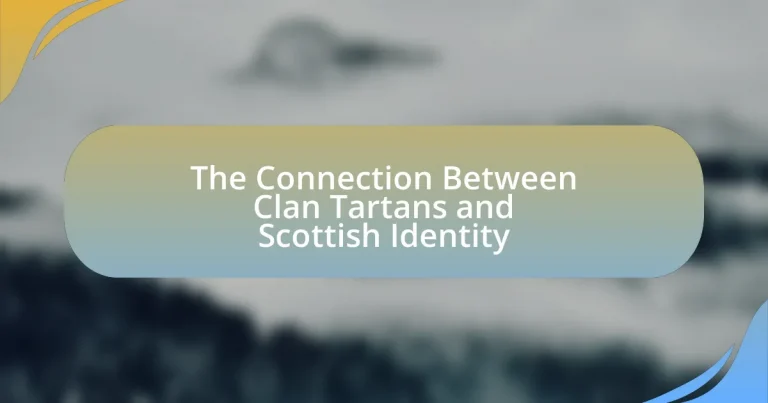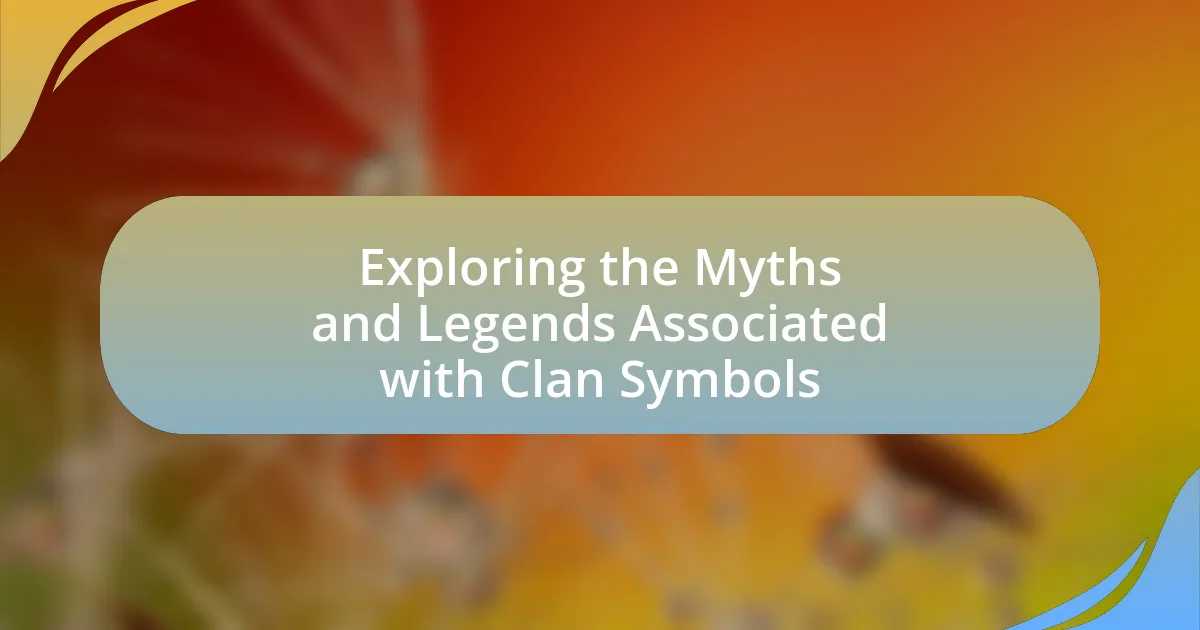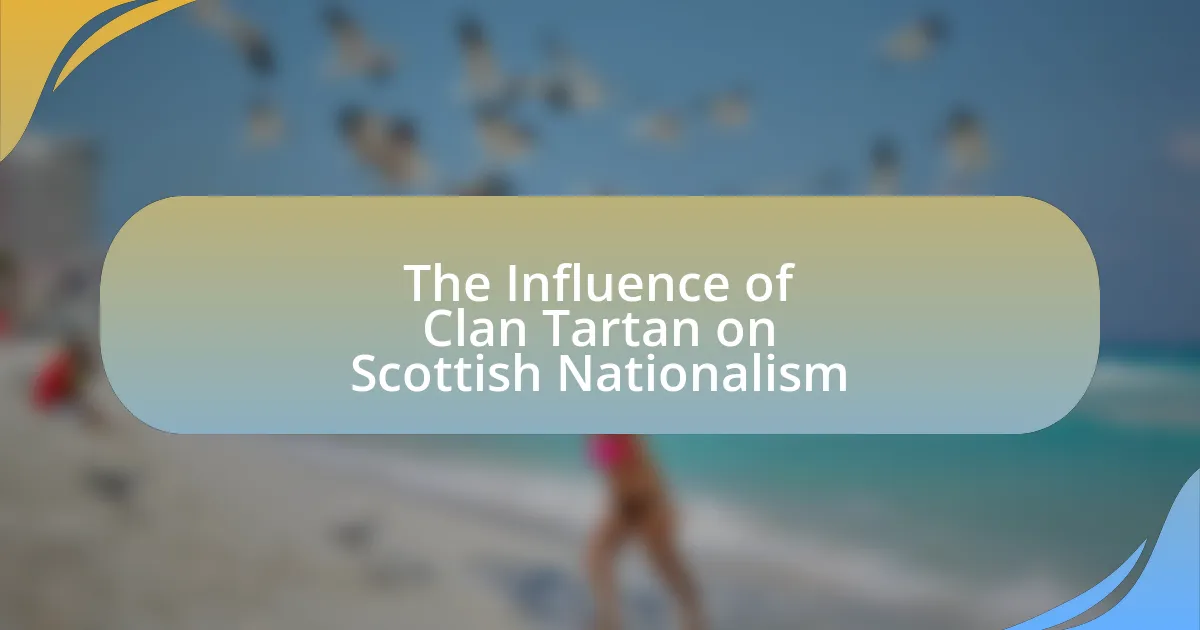Clan tartans are integral to Scottish identity, symbolizing heritage, lineage, and cultural pride. Each tartan pattern is uniquely associated with a specific clan, reflecting its history and fostering a sense of belonging among members. The article explores the historical significance of clan tartans, their role in representing regional identities, and their evolution over time, including the impact of globalization and contemporary interpretations. Additionally, it discusses the importance of preserving traditional tartans and the ways individuals can connect with their Scottish heritage through these distinctive patterns.
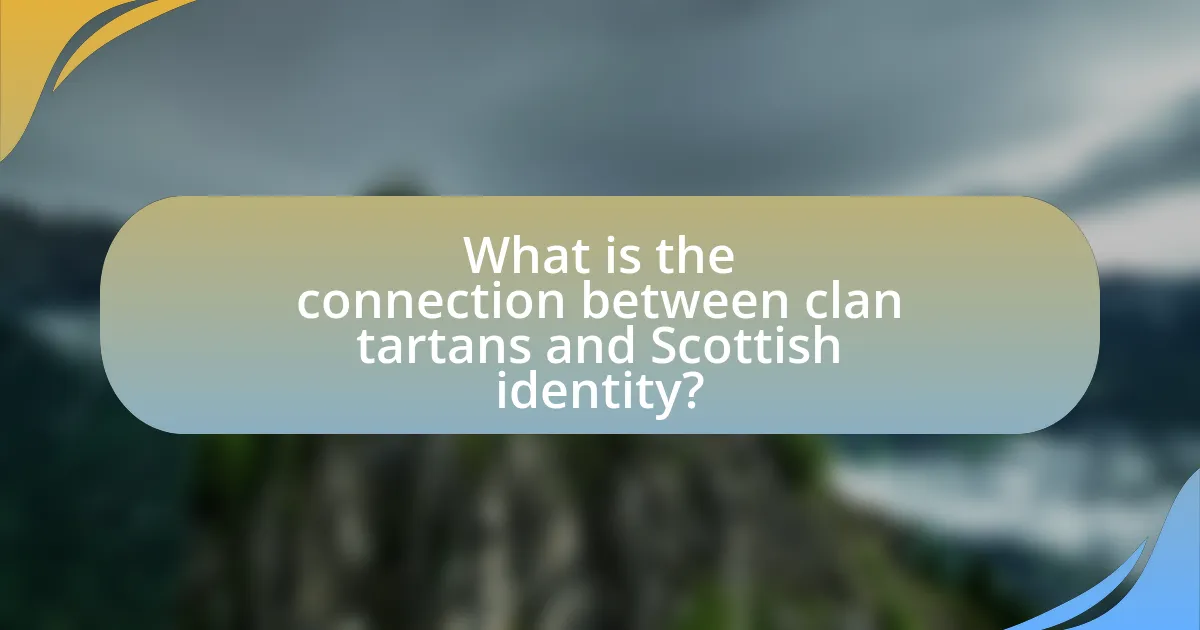
What is the connection between clan tartans and Scottish identity?
Clan tartans are deeply intertwined with Scottish identity as they symbolize heritage, lineage, and cultural pride. Each tartan pattern is associated with a specific clan, representing the history and traditions of that clan, which fosters a sense of belonging among its members. Historically, tartans were used to identify clans during conflicts and gatherings, reinforcing social cohesion and unity. The Scottish Tartan Act of 2008 further solidified this connection by recognizing tartans as a vital part of Scotland’s cultural heritage, thus affirming their role in shaping national identity.
How do clan tartans represent Scottish heritage?
Clan tartans represent Scottish heritage by serving as distinctive patterns that symbolize individual clans and their histories. Each tartan design is associated with a specific clan, reflecting its unique identity, lineage, and cultural significance. Historically, tartans were used to identify members of clans, especially during battles, and they have evolved into a symbol of pride and unity among Scots. The use of specific colors and patterns in tartans often relates to the geographical region of the clan, further embedding the connection to Scottish land and culture. This deep-rooted association is evidenced by the fact that tartans are often worn during significant cultural events, such as Highland games and weddings, reinforcing their role as a representation of Scottish identity and heritage.
What historical events influenced the development of clan tartans?
The development of clan tartans was significantly influenced by historical events such as the Jacobite uprisings in the 17th and 18th centuries. These uprisings, particularly the 1745 rebellion led by Charles Edward Stuart, heightened the visibility and importance of clan identities in Scotland. Following the defeat of the Jacobites, the British government imposed the Dress Act of 1746, which banned the wearing of tartan and other Scottish dress, further solidifying tartan as a symbol of Scottish identity and resistance. The subsequent repeal of this act in 1782 allowed for the revival and popularization of tartans, leading to their association with specific clans and the establishment of distinct patterns that represented clan heritage.
How do clan tartans reflect regional identities within Scotland?
Clan tartans reflect regional identities within Scotland by visually representing the heritage and history of specific clans associated with particular geographic areas. Each tartan pattern is unique to a clan, often incorporating colors and designs that symbolize local landscapes, historical events, or clan lineage. For example, the MacLeod tartan features colors that evoke the natural environment of the Isle of Skye, where the clan originated. This connection to place reinforces a sense of belonging and pride among clan members, as tartans serve as a tangible link to their regional identity and cultural heritage.
Why are clan tartans significant to Scottish culture?
Clan tartans are significant to Scottish culture because they serve as a visual representation of clan identity and heritage. Each tartan pattern is uniquely associated with a specific clan, symbolizing loyalty, kinship, and a shared history among its members. Historically, tartans were used to distinguish different clans, especially during the Jacobite uprisings in the 18th century, when they became a symbol of Scottish nationalism and pride. The Scottish Tartan Act of 1815 further solidified their importance by regulating the use of tartans, ensuring that each clan’s pattern was preserved and recognized. This cultural significance continues today, as tartans are worn during ceremonies, celebrations, and events, reinforcing a sense of belonging and cultural continuity among Scots and those of Scottish descent worldwide.
What role do clan tartans play in Scottish ceremonies and celebrations?
Clan tartans serve as significant symbols of identity and heritage during Scottish ceremonies and celebrations. They represent specific clans, allowing individuals to express their lineage and cultural pride. For instance, during events like weddings, Highland games, and clan gatherings, wearing a clan tartan fosters a sense of belonging and unity among members of the same clan. Historically, tartans have been used to distinguish clans in battle and signify allegiance, reinforcing their importance in Scottish culture. The use of tartans in these contexts not only honors tradition but also strengthens communal ties, making them integral to the celebration of Scottish identity.
How do clan tartans foster a sense of belonging among Scots?
Clan tartans foster a sense of belonging among Scots by symbolizing shared heritage and identity. Each tartan is uniquely associated with a specific clan, representing familial ties and historical connections that unite individuals under a common banner. This visual representation of identity reinforces community bonds, as wearing a clan tartan signifies pride in one’s ancestry and belonging to a larger group. Historically, clan tartans have been used in ceremonies, gatherings, and celebrations, further solidifying their role in fostering unity and a collective identity among Scots.
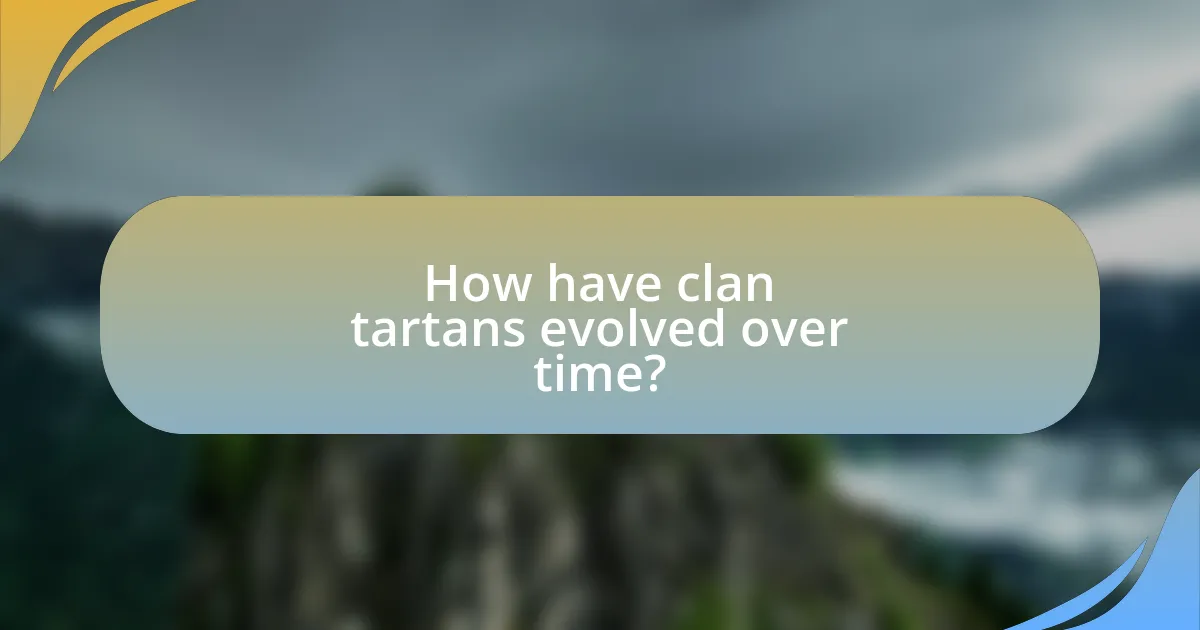
How have clan tartans evolved over time?
Clan tartans have evolved significantly over time, transitioning from simple, handwoven patterns to complex designs that symbolize clan identity and heritage. Initially, tartans were created using natural dyes and varied in color and pattern based on local resources and weaving techniques. By the 18th century, the introduction of synthetic dyes and industrial weaving methods allowed for greater variety and accessibility, leading to the establishment of specific tartans associated with particular clans. The 19th century saw the romanticization of tartans, particularly during the Victorian era, when they became emblematic of Scottish nationalism and identity, culminating in the formalization of clan tartans by the Scottish Tartans Authority in the 20th century. This evolution reflects broader social and cultural changes within Scotland, illustrating how tartans have become a vital aspect of Scottish identity and heritage.
What changes have occurred in the design of clan tartans?
The design of clan tartans has evolved significantly over time, reflecting changes in cultural identity and fashion. Historically, tartans were primarily made from wool and featured simple patterns that represented specific clans. In recent years, the introduction of synthetic fibers and digital printing technology has allowed for more vibrant colors and intricate designs, broadening the appeal of tartans beyond traditional uses. Additionally, there has been a trend towards the creation of “modern” tartans, which often incorporate non-traditional colors and patterns to cater to contemporary tastes, while still maintaining a connection to clan heritage. This evolution illustrates how clan tartans have adapted to modern aesthetics while preserving their cultural significance.
How have modern interpretations of clan tartans emerged?
Modern interpretations of clan tartans have emerged through a combination of cultural revival, commercial interests, and individual expression. The late 20th century saw a resurgence in interest in Scottish heritage, leading to the creation of new tartans that reflect contemporary values and identities. For instance, organizations like the Scottish Tartans Authority have documented over 7,000 registered tartans, many of which are modern adaptations or entirely new designs that cater to personal or regional identities. This evolution illustrates how tartans have transitioned from traditional symbols of clan allegiance to broader representations of Scottish identity, allowing for personal customization and expression in various contexts, such as fashion and home decor.
What impact has globalization had on the use of clan tartans?
Globalization has significantly increased the visibility and commercialization of clan tartans, leading to a broader acceptance and usage beyond traditional Scottish contexts. As global markets expand, tartans are now frequently used in fashion, home decor, and branding, often detached from their original cultural significance. This shift is evidenced by the rise of tartan-themed products in international retail, which has diluted the exclusive association of specific patterns with particular clans. Furthermore, the internet facilitates the sharing of tartan designs and histories, allowing individuals worldwide to adopt and adapt these symbols, thereby transforming clan tartans into a global cultural commodity rather than a strictly Scottish identity marker.
Why is the preservation of clan tartans important today?
The preservation of clan tartans is important today because they serve as a vital symbol of Scottish heritage and identity. Clan tartans represent familial ties, cultural history, and regional pride, fostering a sense of belonging among Scots and those of Scottish descent. The continued use and recognition of these patterns help maintain cultural traditions and promote awareness of Scotland’s rich history, as evidenced by the global popularity of tartan in fashion and events like the Highland Games, which celebrate Scottish culture.
What efforts are being made to maintain traditional tartan patterns?
Efforts to maintain traditional tartan patterns include the establishment of organizations like the Scottish Tartans Authority, which works to preserve and promote the history and authenticity of tartans. Additionally, educational programs and workshops are conducted to teach weaving techniques and the cultural significance of tartans to new generations. The Scottish Register of Tartans, created in 2008, serves as an official record, ensuring that traditional patterns are documented and protected from misuse. These initiatives collectively support the ongoing relevance of tartan patterns in Scottish identity and heritage.
How do contemporary designers incorporate clan tartans into fashion?
Contemporary designers incorporate clan tartans into fashion by using these traditional patterns in modern clothing designs, often blending them with contemporary silhouettes and materials. Designers like Vivienne Westwood and Alexander McQueen have famously utilized tartans to evoke Scottish heritage while appealing to modern aesthetics. This integration not only celebrates cultural identity but also revitalizes interest in traditional textiles, as seen in collections that feature tartan skirts, jackets, and accessories, which have become staples in both high fashion and streetwear. The use of clan tartans in fashion serves to connect wearers with their ancestry, reinforcing the significance of Scottish identity in contemporary culture.

What are the practical implications of clan tartans in contemporary society?
Clan tartans serve as a symbol of Scottish identity and heritage in contemporary society, influencing cultural pride and community cohesion. These distinctive patterns are often worn during cultural events, weddings, and festivals, reinforcing a sense of belonging among individuals who identify with specific clans. Additionally, clan tartans have practical implications in the fashion industry, where they are utilized in clothing and accessories, promoting Scottish craftsmanship and tourism. The global popularity of tartan has led to increased interest in Scottish culture, as evidenced by the rise in attendance at events like the Edinburgh Festival and Highland Games, which celebrate this heritage.
How can individuals connect with their Scottish heritage through clan tartans?
Individuals can connect with their Scottish heritage through clan tartans by wearing or displaying the specific tartan associated with their clan, which symbolizes their ancestral lineage and cultural identity. Each clan has a unique tartan pattern that represents its history and values, allowing individuals to express pride in their heritage. For example, the MacGregor tartan is linked to the MacGregor clan, which has a rich history dating back to the 14th century. By choosing to wear or utilize these tartans in clothing, accessories, or home decor, individuals reinforce their connection to their Scottish roots and participate in the ongoing tradition of clan identity.
What resources are available for learning about clan tartans?
Resources available for learning about clan tartans include books, online databases, and museums. Notable books such as “Scottish Tartans: The Complete Guide” by Ian Campbell provide comprehensive insights into the history and significance of various clan tartans. Online databases like the Scottish Tartans Authority’s website offer extensive records and images of tartans associated with specific clans. Additionally, museums such as the National Museum of Scotland feature exhibits on Scottish textiles, including tartans, which help contextualize their cultural importance. These resources collectively enhance understanding of the connection between clan tartans and Scottish identity.
How can one choose the right tartan for personal or family use?
To choose the right tartan for personal or family use, one should first identify their clan affiliation or family heritage, as many tartans are associated with specific clans in Scotland. Each clan has its own unique tartan pattern, which reflects its history and identity; for example, the MacDonald tartan is distinct and recognized among its members. Additionally, individuals can consider the color palette and design of the tartan, ensuring it resonates with personal taste while honoring family traditions. Resources such as the Scottish Register of Tartans provide official records and images of various tartans, aiding in the selection process.
What are the best practices for wearing and displaying clan tartans?
The best practices for wearing and displaying clan tartans include wearing them with respect to their cultural significance and adhering to traditional guidelines. Clan tartans should be worn during formal occasions, such as weddings and clan gatherings, to honor heritage. Additionally, individuals should ensure that they wear the correct tartan associated with their clan, as each tartan represents a specific lineage and history. Displaying clan tartans in homes or public spaces should be done in a manner that reflects their importance, such as framing fabric samples or using them in decorative items, while avoiding any disrespectful or inappropriate uses. These practices reinforce the connection between clan tartans and Scottish identity, emphasizing pride in heritage and tradition.
